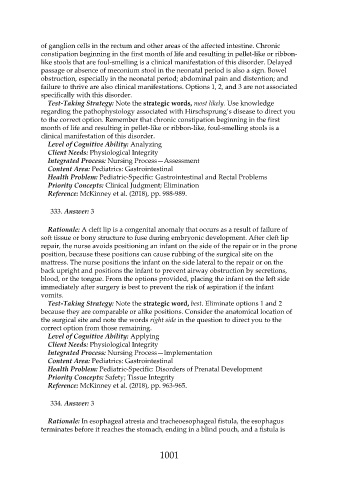Page 1001 - Saunders Comprehensive Review For NCLEX-RN
P. 1001
of ganglion cells in the rectum and other areas of the affected intestine. Chronic
constipation beginning in the first month of life and resulting in pellet-like or ribbon-
like stools that are foul-smelling is a clinical manifestation of this disorder. Delayed
passage or absence of meconium stool in the neonatal period is also a sign. Bowel
obstruction, especially in the neonatal period; abdominal pain and distention; and
failure to thrive are also clinical manifestations. Options 1, 2, and 3 are not associated
specifically with this disorder.
Test-Taking Strategy: Note the strategic words, most likely. Use knowledge
regarding the pathophysiology associated with Hirschsprung’s disease to direct you
to the correct option. Remember that chronic constipation beginning in the first
month of life and resulting in pellet-like or ribbon-like, foul-smelling stools is a
clinical manifestation of this disorder.
Level of Cognitive Ability: Analyzing
Client Needs: Physiological Integrity
Integrated Process: Nursing Process—Assessment
Content Area: Pediatrics: Gastrointestinal
Health Problem: Pediatric-Specific: Gastrointestinal and Rectal Problems
Priority Concepts: Clinical Judgment; Elimination
Reference: McKinney et al. (2018), pp. 988-989.
333. Answer: 3
Rationale: A cleft lip is a congenital anomaly that occurs as a result of failure of
soft tissue or bony structure to fuse during embryonic development. After cleft lip
repair, the nurse avoids positioning an infant on the side of the repair or in the prone
position, because these positions can cause rubbing of the surgical site on the
mattress. The nurse positions the infant on the side lateral to the repair or on the
back upright and positions the infant to prevent airway obstruction by secretions,
blood, or the tongue. From the options provided, placing the infant on the left side
immediately after surgery is best to prevent the risk of aspiration if the infant
vomits.
Test-Taking Strategy: Note the strategic word, best. Eliminate options 1 and 2
because they are comparable or alike positions. Consider the anatomical location of
the surgical site and note the words right side in the question to direct you to the
correct option from those remaining.
Level of Cognitive Ability: Applying
Client Needs: Physiological Integrity
Integrated Process: Nursing Process—Implementation
Content Area: Pediatrics: Gastrointestinal
Health Problem: Pediatric-Specific: Disorders of Prenatal Development
Priority Concepts: Safety; Tissue Integrity
Reference: McKinney et al. (2018), pp. 963-965.
334. Answer: 3
Rationale: In esophageal atresia and tracheoesophageal fistula, the esophagus
terminates before it reaches the stomach, ending in a blind pouch, and a fistula is
1001

